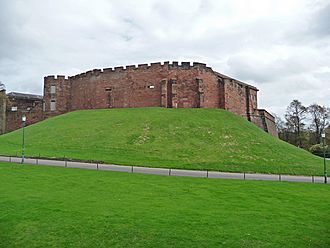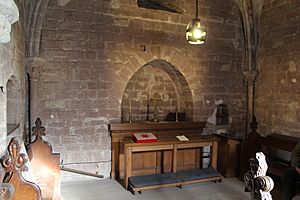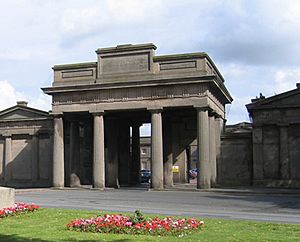Chester Castle facts for kids
Quick facts for kids Chester Castle |
|
|---|---|

Chester Castle
|
|
| General information | |
| Architectural style | Norman, Neoclassical |
| Town or city | Chester, Cheshire |
| Country | England |
| Coordinates | 53°11′07″N 2°53′32″W / 53.1853°N 2.8923°W |
| Construction started | 1070 |
| Completed | 1822 |
| Design and construction | |
| Architect | Thomas Harrison |
Chester Castle is a historic building in the city of Chester, England. It is located in the southwest part of the city, near the old city walls. The castle sits on a hill, looking over the River Dee.
Today, Chester Castle is a mix of old and new. You can see parts of the original medieval castle. There are also newer buildings designed by Thomas Harrison. These were built between 1788 and 1813 in a style called Neoclassical. Some of these newer buildings are now used by the Crown Court and as a military museum. Both the museum and the ancient castle ruins are popular places for tourists to visit.
Contents
The Castle's Long History
Building the First Castle
Chester Castle was first built in 1070. It was created by Hugh d'Avranches, who was the second Earl of Chester. It might have been built on the site of an even older Saxon fort.
The very first castle was a motte-and-bailey type. This means it had a large mound (motte) with a wooden tower on top. It also had a fenced area (bailey) below.
Changes Over Time
In the 1100s, the wooden tower was replaced. A strong, square stone tower, called the Flag Tower, was built instead. During the same century, a stone gate was added to the inner part of the castle. This gate is now known as the Agricola Tower. Inside, on the first floor, is the chapel of St Mary de Castro. This chapel still has parts of its original Norman design.
In the 1200s, during the time of King Henry III, more walls were built. These walls created an outer bailey, which was another protected area. The old gateway in the Agricola Tower was closed off. New living spaces, including a Great Hall, were built along the south wall.
Later in the 1200s, under King Edward I, a new main gate was built for the outer bailey. This gate had two round towers on either side. It also had a drawbridge over a deep moat, which was about 8 meters (26 feet) deep. More additions were made, like special rooms for the King and Queen, a new chapel, and stables for horses.
Famous Prisoners and Events
Many important people were held as prisoners in the crypt (an underground room) of the Agricola Tower. These included King Richard II and Eleanor Cobham. She was the wife of Humphrey, Duke of Gloucester. Andrew de Moray, a Scottish hero, was also held there.
During the Wars of the Roses, a big fight between two families for the English throne, John Neville, 1st Marquess of Montagu was captured. He was held at the castle in 1459. He was later set free.
Outside the castle's outer gate was a place called the Gloverstone. This is where people who had broken serious laws were handed over to the city. The Great Hall was rebuilt in the late 1570s.
The Civil War and Beyond
During the English Civil War, Chester was controlled by the Royalists. The castle was attacked by Parliamentary forces several times. It was under a siege (surrounded by enemy forces) from September 1645 to February 1646.
After the Civil War, the castle was used for different purposes. It became a prison, a court, and even a tax office. In 1687, King James II attended a church service in the chapel of St Mary de Castro. In 1696, a place to make coins, called the Chester mint, was set up nearby.
In the mid-1700s, the castle started to fall apart. John Howard, who worked to make prisons better, said the prison conditions were very bad.
New Buildings by Thomas Harrison
Thomas Harrison was hired to design a new prison. It was finished in 1792 and was considered one of the best prisons in the country. Harrison then rebuilt the medieval Shire Hall, which was a court building. He designed it in the Neoclassical style.
He also added two new sections to the castle. One was for barracks (where soldiers live). The other was an armoury (where weapons are stored). Harrison also designed a grand new entrance to the castle, called the Propylaeum. All these new buildings were in the Neoclassical style. They were built between 1788 and 1822. An expert on buildings, Nikolaus Pevsner, said Harrison's work was "one of the most powerful monuments" of the Greek Revival style in England.
In 1867, an Irish group tried to raid the castle to get weapons. This attempt was not successful.
Military Use
The Army took over the castle. In 1873, it became a main base for the 22nd (Cheshire) Regiment of Foot. This was part of changes to how the army was organized. The castle remained the main base for the Cheshire Regiment until 1939. At that time, the regiment moved to Dale Barracks.
In 1925, the crypt and chapel in the Agricola Tower were blessed again. They had been used as a warehouse and for storing ammunition for 200 years. The chapel was refurnished in 1939.
Chester Castle Today
Today, you enter the castle complex through the Propylaeum. This is a very important historic building. It has large columns supporting a heavy top section. On either side are smaller buildings that look like temples.
Straight ahead is the former Shire Hall. This building now holds the Crown Courts. It has many windows, and the central part sticks out with more columns. To your left is the old barracks building. This is now home to the Cheshire Military Museum and a place for army cadets. To your right is the building that was once an armoury. It later became an officers' mess. Both of these buildings are also important historic structures in the Neoclassical style.
Exploring the Old Castle Parts
Further to the right, you can find the remains of the original Norman castle. The Agricola Tower is a very important historic building. It is made of sandstone and has a metal roof. The ground floor has a blocked-up gateway. Inside, the ground floor has a crypt. The first floor holds the chapel of St Mary Castro.
The chapel is still used as the special chapel for the Cheshire Regiment. Its ceiling has old paintings from the early 1200s. These paintings show scenes like the Visitation and miracles performed by the Virgin Mary. They were discovered during restoration work in the 1990s.
The old walls to the south and west of the castle are also very important. These include the Halfmoon Tower, the Flag Tower, and a place where guns were once set up. Other walls within the castle grounds are also protected. In the castle courtyard, there is a statue of Queen Victoria from 1903. The inner part of the castle is looked after by the local council and English Heritage.
See also
- Governor of Chester
- Siege of Chester
- Castles in Great Britain and Ireland
- List of castles in England
- List of castles in Cheshire
- Grade I listed buildings in Cheshire West and Chester
- Listed buildings in Chester Castle parish
- Norman architecture in Cheshire
- List of Scheduled Monuments in Cheshire (1066–1539)
- List of works by Thomas Harrison





